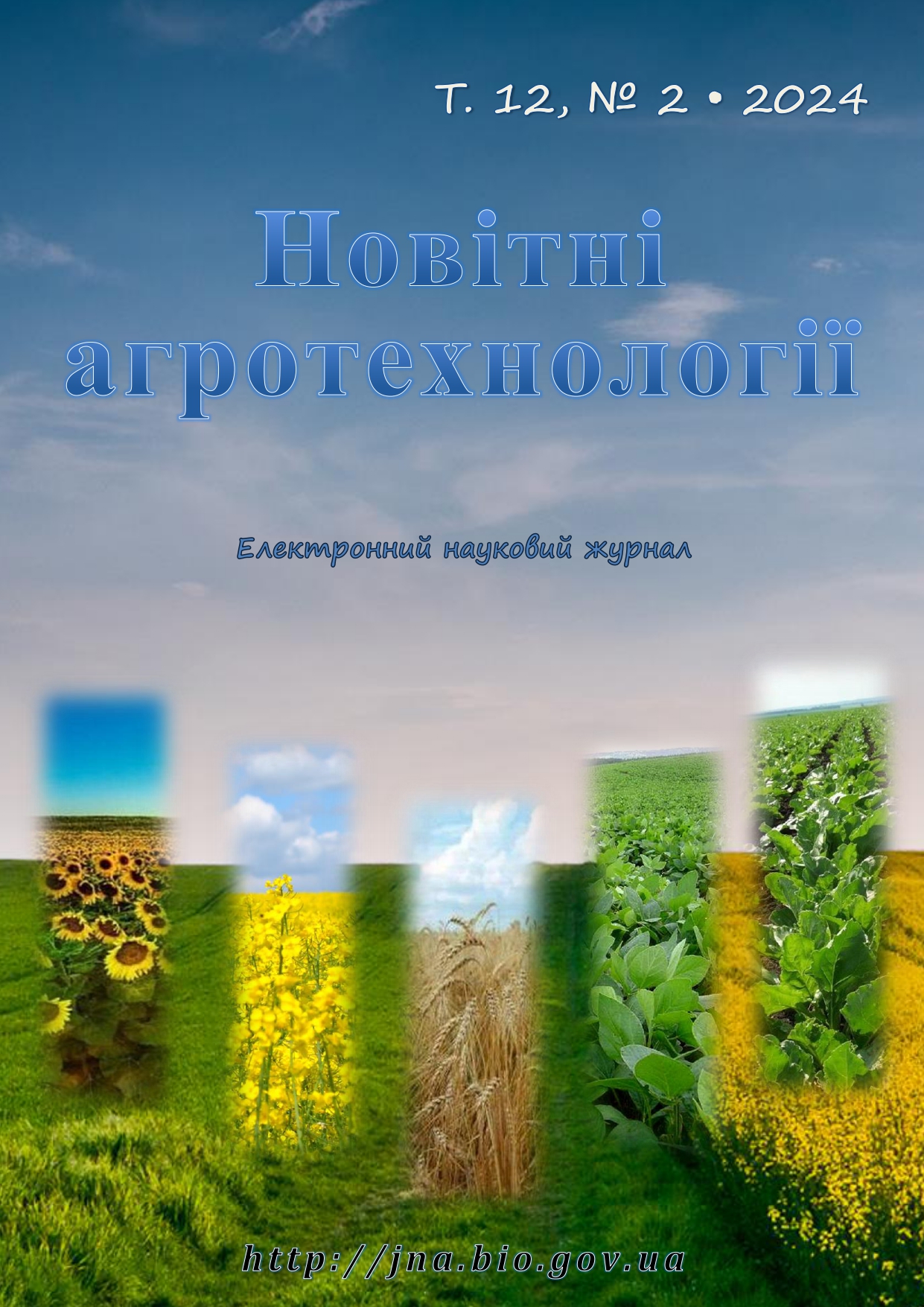Урожайність кіноа (Chenopōdium quīnoa Willd.) залежно від холодової стратифікації насіння
DOI:
https://doi.org/10.47414/na.12.2.2024.308580Ключові слова:
кіноа (Chenopōdium quīnoa Willd.), насіння, холодова стратифікація, вегетація, висота рослин, індивідуальна продуктивність, урожайністьАнотація
Мета. Виявити вплив холодової стратифікації насіння на ріст, розвиток та формування врожайності кіноа.
Методи. Дослідження проводили у 2022–2023 рр. у навчально-науковій лабораторії «Демонстраційне колекційне поле сільськогосподарських культур» кафедри рослинництва Національного університету біоресурсів і природокористування України (м. Київ) та в лабораторіях кафедри рослинництва НУБіП України «Якості насіння та садивного матеріалу» та «Аналітичні дослідження в рослинництві». Схема досліду: 1) контрольне насіння (КН); 2) стратифіковане насіння (СН) – після тривалої (7 діб) дії низьких позитивних (0…4 °С) температур у ходильній камері. Площа ділянки в дрібноділянковому досліді – 2 м2, повторність – шестиразова.
Результати. Стратифіковане насіння сорту ՙКвартет՚ проростало швидше за контрольне, сходи з’являлися на 5 добу після сівби. Фенологічні фази цвітіння й достигання в рослин кіноа, вирощених з насіння після холодової стратифікації, тривали довше порівняно з рослинами на контрольних ділянках. Холодова стратифікація насіння сприяла тривалішому вегетаційному періоду та підвищенню висоти рослин – до 116,3 см. Витримування насіння кіноа в умовах тривалої (7 діб) дії низьких позитивних (0…4 °С) температур у ходильній камері сприяло підвищенню довжина волоті на 3,2 %, кількость гілочок на волоті – на 8 %, маси насіння з однієї рослини – на 2,3 %, маси 1000 насінин – на 3,9 %. Урожайність культури досягала 1,86 т/га.
Висновки. Холодова стратифікація насіння кіноа перед сівбою сприяє прискоренню схожості й швидкості проростання, польова схожість підвищується на 5 %, сходи з’являються на 4 доби раніше, вегетаційний період подовжується. Витримування насіння кіноа в умовах тривалої (7 діб) дії низьких позитивних (0…4 °С) температур у ходильній камері сприяє підвищенню показників індивідуальної продуктивності рослин та на 2,8 % врожайності культури.
Посилання
Bazile, D., Pulvento, C., Verniau, A., Al-Nusairi, M. S., Ba, D., Breidy, J., ... Padulosi, S. (2016). Worldwide evaluations of quinoa: preliminary results from post international year of quinoa FAO projects in nine countries. Frontiers in Plant Science, 7. Article 850. doi: 10.3389/fpls.2016.00850
Walters, H., Carpenter-Boggs, L., Desta, K., Yan, L., Matanguihan, J., & Murphy, K. (2016). Effect of irrigation, intercrop, and cultivar on agronomic and nutritional characteristics of quinoa. Agroecology and Sustainable Food Systems, 40, 783–803. doi: 10.1080/21683565.2016.1177805
Jacobsen, S-E. (2017). The scope for adaptation of quinoa in Northern Latitudes of Europe. Journal of Agronomy and Crop Science, 203(6), 603–613. doi: 10.1111/jac.12228
FAO (2011). «Resolution» in Quinoa: An ancient crop to contribute with world food security, FAO regional Office for Latin America and the Caribbean. Santiago de Chile: Food and Agriculture Organization of the United Nations. Retrieved from https://www.fao.org/4/aq287e/aq287e.pdf
Trotsenko, V. I., Kovalenko, I. M., & Ilchenko, V. O. (2017). Status and prospects of quinoa culture in the northeastern forest-steppe of Ukraine. Bulletin of the Sumy National Agrarian University. Series: Agronomy and Biology, 9, 77–81. [In Ukrainian]
Alandia, G., Rodriguez, J., Jacobsen, S.-E., Bazile, D., & Condori, B. (2020). Global expansion of quinoa and challenges for the Andean region. Global Food Security, 26, Article 100429. doi: 10.1016/j.gfs.2020.100429
FAOSTAT. (2022). FAOSTAT Database. Retrieved from https://www.fao.org/faostat/en/#data/QCL
Xiu-Shi, Y., Pei-You, Q., Hui-Min, G., & Gui-Xing, Y. R. (2019). Quinoa industry development in China. International Journal of Agriculture and Natural Resources, 46, 208–219. doi: 10.7764/rcia.v46i2.2157
Statista. Retrieved from https://www.statista.com/statistics/486411/us-quinoa-imports/#:~:text=This%20statistic%20features%20quinoa%20imports,kilograms%20in%20the%20previous%20year
Walters, R. (2013). Pseudocereals: Super Foods, or Pantry Hokum (en línea). Retrieved from http://open-furrowagrosphere.net/Documents/UTW/Psuedocereals.pdf
Trotsenko, V. I., & Vandyk, M. I. (2023). Prospects for the spread of quinoa in the northeastern forest-steppe of Ukraine. In Ricerche scientifiche e metodi della loro realizzazione: esperienza mondiale e realtà domestiche (pp. 48–49). Bologna, Repubblica Italiana. doi: 10.36074/logos-03.03.2023.13 [In Ukrainian]
Vega-Gálvez, A., Miranda, M., Vergara, J., Uribe, E., Puente, L., & Martínez, E. A. (2010). Nutrition facts and functional potential of quinoa (Chenopodium quinoa Willd.), an ancient Andean grain: a review. Journal of the Science of Food and Agriculture, 90(15), 2541–2547. doi: 10.1002/jsfa.4158
Mohyuddin, S. G. (2023). Quinoa is beneficial to the comprehensive nutritional value of potential health. Pakistan Journal of Science, 71(2), 69–74. doi: 10.57041/pjs.v71i2.272
Sindhu, R., & Khatkar, B. S. (2019). Pseudocereals: nutritional composition, functional properties, and food applications. In S. C. Deka, & D. Seth (Eds.), Food Bioactives (pp. 129–147). New Jersey: Apple Academic Press.
Olivera, L., Best, I., Paredes, P., Perez, N., Chong, L., & Marzano, A. (2022). Nutritional value, methods for extraction and bioactive compounds of quinoa. IntechOpen, 2022. doi: 10.5772/intechopen.101891
Pathan, S., & Siddiqui, R. A. (2022). Nutritional Composition and Bioactive Components in Quinoa (Chenopodium quinoa Willd.) Greens: A Review. Nutrients, 14(3), Article 558. doi: 10.3390/nu14030558
Bazile, D., & Baudron, F. (2015). The dynamics of the global expansion of quinoa growing in view of its high biodiversity. In D. Bazile, H. D. Bertero, & C. Nieto (Eds.), State-of-the-art report of quinoa in the world in 2013 (pp. 42–55). Rome: FAO and CIRAD. Retrieved from https://www.fao.org/3/a-i4042e.pdf
Gordillo-Bastidas, E., Diaz-Rizzolo, D. A., Roura, E., Massanes, T., & Gomis, R. (2016). Quinoa (Chenopodium quinoa Willd), from nutritional value to potential health benefits: an integrated review. Journal of Nutrition & Food Sciences, 6(3), Article 497. doi: 10.4172/2155-9600.1000497
Villacrés, E., Quelal, M., Galarza, S., Iza, D., & Silva, E. (2022). Nutritional Value and Bioactive Compounds of Leaves and Grains from Quinoa (Chenopodium quinoa Willd.). Plants (Basel), 11(2), Article 213. doi: 10.3390/plants11020213
Rojas, W., Pinto, M., Alanoca, C., Gómez, P. L., Leon-Lobos, P., & Alercia, A. (2015). Quinoa genetic resources and ex-situ conservation. In D. Bazile (Ed.), State of the art report on quinoa around the world in 2013 (pp. 56–82). Rome: FAO.
Vilcacundo, R., & Hernández-Ledesma, B. (2017). Nutritional, and biological value of quinoa (Chenopodium quinoa Willd.). Current Opinion Food Science, 14, 1–6. doi: 10.1016/j.cofs.2016.11.007
Fuentes, F., & Bhargava, A. (2011). Morphological analysis of quinoa germplasm grown under lowland desert conditions. Journal of Agronomy and Crop Science, 197, 124–134. doi: 10.1111/j.1439-037X.2010.00445.x
Rao, N. K., & Shahid, M. (2012). Quinoa – a promising new crop for the Arabian peninsula. American-Eurasian Journal of Agricultural & Environmental Sciences, 2, 1350–1355. doi: 10.5829/idosi.aejaes.2012.12.10.1823
Langyan, S., Khan, F. N., & Kumar, A. (2024). Advancement in Nutritional Value, Processing Methods, and Potential Applications of Pseudocereals in Dietary Food: A Review. Food Bioprocess Technology, 17, 571–590. doi: 10.1007/s11947-023-03109-x
Hinojosa, L., González, J. A., Barrios-Masias, F. H., Fuentes, F., & Murphy, K. M. (2018). Quinoa abiotic stress responses: a review. Plants, 7(4), Article 106. doi: 10.3390/plants7040106
Fathi, A., & Kardoni, F. (2020). The importance of quinoa (Quinoa chenopodium Willd.) cultivation in developing countries: a review. Cercetări Agronomice în Moldova, 53(3), 337–356. doi: 10.46909/cerce-2020-030
Bandurska, H. (2022). Drought Stress Responses: Coping Strategy and Resistance. Plants (Basel), 11(7), Article 922. doi: 10.3390/plants11070922
Gámez, A. L., Soba, D., Zamarreño, Á. M., García-Mina, J. M., Aranjuelo, I., & Morales, F. (2019). Effect of water stress during grain filling on yield, quality and physiological traits of illpa and rainbow quinoa (Chenopodium quinoa Willd.) cultivars. Plants, 8(6), Article 173. doi: 10.3390/plants8060173
Bhargava, A., Shukla, S., & Ohri, D. (2006). Chenopodium quinoa – an Indian perspective. Industrial Crops and Products, 23(1), 73–87. doi: 10.1016/j.indcrop.2005.04.002
Pathan, S., Ndunguru, G., Clark, K., & Ayele, A. G. (2023). Yield and nutritional responses of quinoa (Chenopodium quinoa Willd.) genotypes to irrigated, rainfed, and drought-stress environments. Frontiers in Sustainable Food Systems, 7. Retrieved from https://www.frontiersin.org/journals/sustainable-food-systems/articles/10.3389/fsufs.2023.1242187
Ruchkina, N. (2017). Kinoa. Chemistry and Life, 4. [In Ukrainian]
Prysiazhniuk, O. I., Karazhbei, H. M., Leshchuk, N. V., Tsyba, S. V., Mazhuha, K. M., Brovkin, V. V., Symonenko, V. A., & Maslechkin, V. V. (2016). Statistical analysis of agronomic research data in the Statistica 10 package: methodological guidelines. Kyiv: Nilan-LTD. [In Ukrainian]
Trotsenko, V. I., Melnyk, A. V., & Trotsenko, N. V. (2020). Study of basic characteristics of quinoа seeds. Bulletin of the Sumy National Agrarian University. Series: Agronomy and biology, 1, 71–77. [In Ukrainian]
Bhargava, A., Shukla, S., & Ohri, D. (2007). Genetic variability and interrelationship among various morphological and quality traits in quinoa (Chenopodium quinoa Willd.). Field Crops Research, 101(1), 104–116. doi: 10.1016/j.fcr.2006.10.001
Hafeez, M. B., Iqbal, S., Li, Y., Saddiq, M. S., Basra, S. M. A., Zhang, H., … Curti, R. N. (2022). Assessment of phenotypic diversity in the USDA collection of quinoa links genotypic adaptation to germplasm origin. Plants, 11(6), Article 738. doi: 10.3390/plants11060738
Saddiq, M. S., Wang, X., Iqbal, S., Hafeez, M. B., Khan, S., Raza, A., … Gulshan, A. B. (2021). Effect of water stress on grain yield and physiological characters of quinoa genotypes. Agronomy, 11, Article 1934. doi: 10.3390/agronomy11101934
Yang, A., Akhtar, S. S., Amjad, M., Iqbal, S., & Jacobsen, S.-E. (2016). Growth and physiological responses of quinoa to drought and temperature stress. Journal of Agronomy and Crop Science, 202(6), 445–453. doi: 10.1111/jac.12167
Spehar, C. R., & Santos, R. L. D. (2005). Agronomic performance of quinoa selected in the Brazilian Savannah. Pesquisa Agropecuária Brasileira, 40, 609–612. doi: 10.1590/S0100-204X2005000600012
Oustani, M., Mehda, S., Halilat, M. T., & Chenchouni, H. (2023). Yield, growth development and grain characteristics of seven quinoa (Chenopodium quinoa Willd.) genotypes grown in open-field production systems under hot-arid climatic conditions. Scientific Reports, 13, Article 1991. doi: 10.1038/s41598-023-29039-4
De Santis, G., Ronga, D., Caradonia, F., Ambrosio, T. D., Troisi, J., Rascio, A., … Rinaldi, M. (2018). Evaluation of two groups of quinoa (Chenopodium quinoa Willd.) accessions with different seed colours for adaptation to the Mediterranean environment. Crop and Pasture Science, 69, 1264–1275. doi: 10.1071/CP18143
##submission.downloads##
Опубліковано
Як цитувати
Номер
Розділ
Ліцензія
Авторське право (c) 2024 С. М. Каленська, Н. В. Новицька, О. М. Мартинов, В. В. Мельниченко, О. П. Чубко, Д. С. Єлізаров

Ця робота ліцензується відповідно до Creative Commons Attribution-ShareAlike 4.0 International License.
"Новітні агротехнології" дотримується авторських прав та дозволів CREATIVE COMMONS для журналів із відкритим доступом.
Автори, які публікуються в цьому журналі, погоджуються з такими умовами:
- автори лишають за собою право на авторство своєї роботи та передають журналу право першої публікації цієї роботи на умовах ліцензії Creative Commons Attribution-ShareAlike 4.0 International License, яка дає змогу іншим особам вільно поширювати опубліковане дослідження з обов'язковим посиланням на авторів оригінальної роботи та першу публікацію роботи в цьому журналі;
- автори мають право укладати самостійні додаткові угоди щодо неексклюзивного розповсюдження роботи такою, якою її було опубліковано цим журналом (наприклад, розміщувати роботу в електронному сховищі установи або публікувати у складі монографії), за умови збереження посилання на першу публікацію роботи в цьому журналі.








